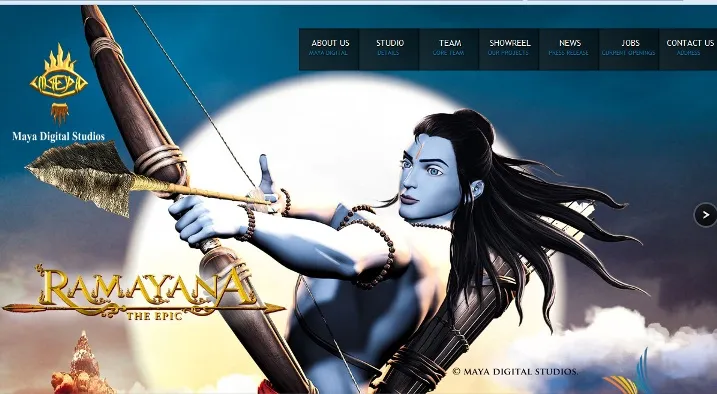Bollywood director, entrepreneur and a pioneer in the Indian animation industry - Ketan Mehta shares his journey
He is the critically acclaimed director of many movies including Mirch Masala and Sardar, who draws inspiration from living subjects. But he also has the knack to narrate great stories using animated virtual characters like he did with Ramayana - The Epic, but ask Ketan Mehta whether he is more a director or an entrepreneur and he says: “I don’t believe living life in compartments. All is an extension of creative urge, a compelling urge. It’s an idea to buy your creative freedom. You need a tool to excel yourself in a particular manner, that is good for you and this new technology is the digital tool in my hands,” he says.
For the uninitiated, Ketan is also the founder of Maya Digital Studios(MDS) -- India’s first animation studio that he started in 1996. He had also founded Maya Academy of Advanced Cinematics, which was invested in by Intel Capital and Enam, who successfully exited it in 2010, when it was sold to Aptech. Today, along with his feature film work, Ketan also oversees production of animated content that MDS is making for TV networks, and says that he enjoys both equally. In a chatty mood, Ketan spoke to YourStory about the beginning, the present and the future. Excerpts.
Birth of Maya
Ketan started Maya because he was not satisfied with the last scene he shot for his movie Maya Memsaab. “Based on French writer Gustave Flaubert's novel Madame Bovary, the last scene was a magical VFX shot, where Deepa Sahi drinks a magic potion and then bursts into a form of light and disappears. At that point in time, there was no technology available in India to do that shot. We tried doing the shot 10 times, it didn’t work out. We even went to Hong Kong to do the shot, but the end result was not fully satisfactory,” recollects Ketan. Maya Memsaab was released in 1993, and Ketan says that was also the time when digital technology was coming into movies and many new “fascinating frontiers was opening up.” At this point the entrepreneur in him spotted the opportunity to create a facility that would soon be adopted by the largest film producing nation, and the result was Maya Digital Studios.

While they opened the studio, they realized there were not enough people in India who could work in the studio and this led to the establishment of Maya Academy of Advanced Cinematics. “We adopted a two-pronged strategy. In the studio, we made India’s first sci-fi TV series called Captain Vyom, which was a big success on Doordarshan (DD) at that time (late 90s). It went on for a full year and required a lot of computer animation and visual effects,” he says. MDS introduced Indian TV to the world of special effects. But the shortage of skilled labour to serve the need was a problem in itself. And Maya Academy of Advanced Cinematics took off in a big way and became a huge franchise, says Ketan. The institute had 70 centres across India and trained about 50,000 animators a year, before its sale. “The institute also contributed to the growth of computer animation and visual effects in India. We are very happy to note that any animation studio that one goes to today, you will find an old Maya person working there,” says Ketan proudly.
Ropes of the business
Ketan says the creative talent of Indians makes them very keen to explore options in creativity and it was same in case of Maya. “People have been very enthusiastic from the beginning, and people took to this technology like duck to water. There has never been any shortage of creative talent in this country, it’s just a question of getting the opportunities and avenues,” he says. While Ketan was no digital technician, he brought in computer geeks who’d dabbled in animation as early employees at the studio. “Mid-90s was very early days even for West. Earlier, animation would only be done on very high-end software and hardware. But, in the mid-90s, it started happening on PCs and that was the interesting turning point in the entire industry,” he shares. This movement of animation, onto the PC platform helped reduce cost of creation and made animation accessible to more people. MDS had a team of 10 people when it began and today has more than 300 people in the team.

We asked him how easy it was to convince DD and advertisers about Captain Vyom, and Ketan says they just had to show them the demo reel and people would get convinced. “Digital technology was still new in the media entertainment space and there was some skepticism about it. We would go with a pilot episode to show and because it was so amazingly different, there was lot of enthusiasm,” says Ketan. In an era, when most tele shows on DD were only made of 13-episodes, Captain Vyom ran for an entire year, which Ketan says was because of viewer interest and SFX.
Maya has also worked with Amar Chitra Katha, Pogo, Disney and Viacom 18 channels in India to create content for them. Ramayana – The Epic and Sons of Ram are the two full-length animated movies that MDS has created. The studio is also planning to release Sholay in 3D this October. MDS has also collaborated with some international productions for creating animated content. And, going forward, Ketan is eager to develop more original content for Indian audiences.
The Indian animation industry is growing into a multi-billion dollar industry. As per a FICCI-KPMG report, the estimated size of Indian animation industry is around $200 million (about Rs 1,100 crore) at present, which is growing at approximately 30% growth rate and is estimated to reach the $1 billion mark by 2014.
The next frontier
While Maya Academy of Advanced Cinematics was sold successfully, MDS recently launched its in studio training initiative – MIST (Maya In Studio Training). Launched last year, MIST allows students to be part of live projects that is being created by MDS. Aruna Kumar, an expert in the education field is heading the venture. The venture provides training on VFX and 3D stereoscopy. In the long term, Ketan says Maya would be a provider of TV series content across all kids channel / broadcaster segment. Plans are also afoot for international co-production.
“When channels launched in India, they were mostly rehashing American or Japanese content, but now they are keen on making original content,” says Ketan.
When Maya Academy of Advanced Cinematics was sold in 2010, the joint entity had a turnover of Rs 150 crore and since moving away, Ketan says they should close this financial year with revenues of Rs 25 crore. Maya has also opened centres in Goa and Singapore. Goa – to manage cost-efficiencies, and for its proximity to Mumbai and Singapore to help them tap easily into the growing global animation industry, says Ketan. “It’s time now to explore international markets for creating our own content, or to get into partnerships with international players, and Singapore will serve as a base for that,” he says.
On his journey as an entrepreneur, Ketan says there have been many ups and downs, nothing less than a roller-coaster ride. His partner and co-founder of Maya – Deepa Sahi - has played a very crucial role in growing the organization and bringing it to the level it is today. We know entrepreneurship is not easy, and Ketan’s mantra to be successful is to: “believe in yourself” – which he says is the beginning and end of things. “When you become an entrepreneur you are also taking up the challenges you find in the market and success can only be achieved if you can tackle those challenges,” he says. He also suggests to get as many people involved in your journey. “If you are creating something new, have more people believe in you and that will improve your chances for success,” suggests the veteran.
In between all this, Ketan is also getting his next movie – ‘Manjhi – The Mountain Man’ ready for release. The movie has used a lot of visual effects created in-house at Maya in the finished product. Watch it for both -- the story and the SFX.
Also make sure you do not miss the Grand Finale of TechSparks 2013, coming up early next month in Bangalore.







